 |
Bhutan Culture |
|
 |
Bhutan Culture |
|
|
 |
These
gigantic structures with their massive walls and elegant woodwork are among
the most impressive forms of architecture in Asia.
 |
Trongsa dzong
The basic pattern of
the dzong is the utse-central tower) which generally houses several temples,
a courtyard surrounded by an outer structure which houses monks' quarters,
administrative offices, and the kitchen. |
|
Trashigang,
Dagana,Mongar, Gasa and Simtokha dzongs are good examples of this pattern,
however, most of the dzongs have two courtyards, sometimes at spilt levels
separated by the central tower.
One
courtyard is for monastic use while the other is for administration. Good
examples of this structure are Punakha, Wangduephodrang, Paro, Thimphu
and Jakar Dzongs. Trongsa is the most complex of all dzongs with an intricate
pattern of buildings, towers and courtyards.
top
|
Chorten
/ Chhoeten (Stupa in Sanskrit)
|
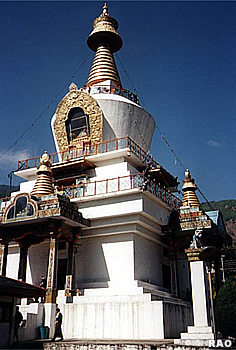 |
| Memorial Chorten in Thimphu |
| Chorten
in Bumthang |
Chortens
are built in memory of eminent lamas or to pin down evil spirits. They
are also built to protect a region against evil spirits at places
which are potentially dangerous such as crossroads and passes as
well as landslide and accident prone areas. |
|
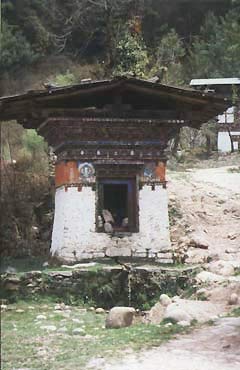 |
Bhutanese
chortens are of three styles:
 |
Huge
stone chortens which are often whitewashed, are built on the model of the
stupa of Boudnath in Nepal. Good examples of this style are Chendebji
(Trongsa), Kurizampa (Mongar) and Chorten Kora (Trashiyangtse). Stone chortens
resembling the Tibetan style are common throughout central and eastern
Bhutan. They are often covered by a wooden frame. |
 |
Chortens
of a purely Bhutanese tradition are primarily widespread in western Bhutan.
Their outer structure is a square stone building with a red stripe at its
upper level and shingle or stone-slab roofs. A chorten of the Tibetan style
is sometimes erected inside that of a local type structure. |
 |
The
Bhutanese style Chorten can also be found in a series of eight, called
the Chorten Degye. These chortens commemorate eight great events of the
life of Lord Buddha and each of them has a different shape. The selection
of a site for the construction of a chortten is suggested by an astrologer;
a Sogshing and the other elements of Zung are put inside the structure
and a consecration ceremony is performed. The Chorten then becomes sacred
and dismantling it is, therefore, a serious sin. |
|
top
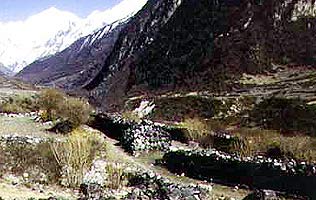 |
Mani-walls
are stone walls that support a number of stones carved with sacred formulas.
These formulas are either those of the three protective Bodhisattvas (Chenrezi,
Jampelyang and Chhana Dorje) or a simple prayer Om Mani Padme Hum, from
which the name has been derived. |
top
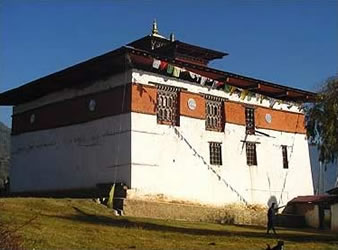 |
Construction
of palaces took place with the coming to power of the Wangchuck dynasty,
starting with Jigme Namgyal, the father of the first king. It can be explained
by the fact that from the end of the last century the country experienced
a period of stability and peace, and the need for fortress type Dzongs
had diminished. Palaces were built between 1870 and 1940 and are mostly
found in the Bumthang and Trongsa regions. Their basic pattern is very
similar to that of a dzong. A central building houses the residence of
the master, and the upper floor, the private chapel. |
It is surrounded by
a courtyard enclosed by an outer structure in which the servants' quarters
and the kitchen are located.
The
palaces have been richly decorated with woodwork, and even the outer building
has been embellished with numerous painted windows. The palaces of Lamey
Goemba, Wangdue Choeling, Ugyen Choeling in Bumthang; Kuenga Rabten, Samdrup
Choeling south of Trongsa Dzong and the mansions of Gangtey in Paro are
good examples. Ugyen Pelri Palace in Paro is different from these palaces
in that it was built on the model of the Zangdopelri (the celestial abode
of Guru Rinpoche) by Paro Poenlop Tshering Penjor around 1930.
top
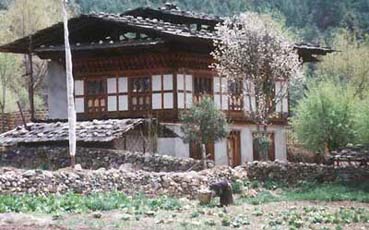 |
House in Bumthang Village
houses are not built of the same material all over the country. While the
western region favors compressed earth (mud) for the walls, the central
and eastern regions use stones. In eastern Bhutan, bamboo is an important
raw material for any construction. In southern Bhutan, houses have mud
walls with thatched roofs. However, houses all over the country display
distinctive uniform features:
|
Rectangular
shape, two or three stories high, upper floors almost totally made of a
framework of wood and plastered bamboo panels, pitched roof and trefoil
shaped windows. The upper floor is used as living quarters and private
chapels while the lower floor is used mainly for keeping domestic animals
and for storage.
During
the past twenty years, the design and structure of the Bhutanese architecture
have changed, especially in urban areas due to the availability of new
materials like cement, steel rods, metal sheets and slates as well as due
to the change of purpose of the buildings. In urban houses, the ground
floor these days is often used for shops. However, the traditional features
of architecture have been maintained. As for the rural houses, they have
improved tremendously. Glass paneled windows, smokeless stoves and improved
latrines are becoming more common; painted designs are applied more and
more lavishly; and the roofs are made of corrugated metal. As with the
dzongs, the rural houses also contribute in giving the landscape in Bhutan
its charm and uniqueness.
| Information on Bhutan |
 |
|







